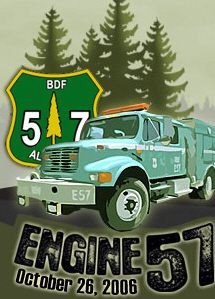During the large vegetation fires in southern California in 2003 the fires were so intense that the windshields on six air tankers were cracked by chunks of debris that were being hurled into the air (page D-6 in 2003 California Governor’s Blue Ribbon Report; huge 20 Mb file). One pilot saw a four by eight sheet of plywood sail past at 1,500 feet.
Currently there are over 100 fires burning in Australia, with about 20 of them being classified as “uncontrollable”. These fires, too, are burning very intensely according to a story in The Australian:
=======================
PILOTS flying hazardous water-bombing missions over bushfire-ravaged Kinglake have described how their aircraft were rocked by the concussion of exploding fuel drums and of steel lids being flung hundreds of feet from the conflagration below.
Fire bomber aircrew fought a desperate battle to save homes but the sheer speed of the Kinglake fire proved overwhelming, said Helicorp chief Steve Graham, whose fleet includes five of the famous orange Erickson Air Cranes.
The dramatic description came from the pilot of one of four helicopters deployed to fight the Kinglake inferno on Saturday night.
“He had lids of 44 gallon drums being sent up by the exploding chemicals and fuel drums in the paddocks and in the houses,” Mr Graham told The Australian.
“Flying among all this he could physically feel the vibrations and concussion of explosions, and then there’s wires, heat and smoke.”
The undisputed king of the aerial bombers is the Air Crane, a modified version of a 1960s heavy-lift chopper capable of dumping 10,000 liters of water.
But the fire fleet this year also comprises medium-size helicopters like the Bell 212 and Bell 205 capable of hauling 1.4 tonnes of water and an assortment of fixed wing aircraft.
Aircrew are typically a mix of American, Canadian, Australian and New Zealanders.
Each Air Crane chopper requires a six-person crew, three pilots and three engineers responsible for a gruelling maintenance schedule demanded by the hard working machines.
Fire bombing is anything but random and requires carefully managed aerial coordination, Mr Graham said.
At the heart of the operation is a flying observer called an aerial attack coordinator.
Armed with a bank of radio sets tuned to the different frequencies of various emergency services on the ground, he receives instructions on targets and directs the water-bombing aircraft.
“If the guy on the ground says, we’ve got a real problem over on this ridge, the guy in the air says thanks very much, we’re on it, and he then directs the heavy artillery into the area that is needed,”Mr Graham said.
The capability of the Air Crane does not come cheap, with one aircraft’s running costs in the order of “tens of thousands of dollars per air hour” Mr Graham said.
Two Air Cranes are normally based out of Sydney, two in Melbourne and one in Adelaide, Mr Graham said.
Helicorp has just signed a five-year contract with the National Aerial Firefighting Centre to provide a fleet of specialised aircraft during the summer bushfire season.



 This is a big relief, but it’s not over yet. Federal prosecutors have a total of five years to decide they will file criminal charges against firefighters.
This is a big relief, but it’s not over yet. Federal prosecutors have a total of five years to decide they will file criminal charges against firefighters.